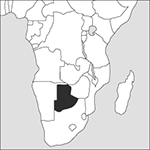
Capital:
Gaborone
Area:
581,730 sq km (224,607 sq miles)
Population:
2,127,825 (2012 est)
Currency:
1 pula = 100 thebe
Religions:
Christian 71.6%; traditional beliefs 6.0%
Ethnic Groups:
Tswana 79.0%; Kalanga 11.0%; Basarwa 3.0%
Languages:
Setswana, English (official); local languages
International Organizations:
UN; AU; SADC; Non-Aligned Movement; Commonwealth; WTO
A landlocked country in southern Africa. It is bordered by Namibia to the west and north, Zimbabwe to the east, and South Africa to the south.
Physical
Botswana lies in the hot, dry central region of southern Africa. The north-west, which has 600 mm (24 inches) of rain a year, drains into a swampy basin, the Okavango, the only surface water in the country. The centre and west is covered by the Kalahari Desert, while in the east is a large salt-pan, the Makgadikgadi.
Economy
Diamonds (both raw and processed) are the chief export, producing revenues that have supported a high growth rate, although Botswana was hit hard when demand for diamonds slumped in the 2009 global recession. It is thought that further mineral wealth awaits discovery; other exports are copper, nickel, soda ash, and beef. Agriculture is mainly pastoral. The government is attempting to use Botswana’s diamond wealth to diversify the economy, and tourism and financial services are increasingly important.
History
Botswana was formerly known as Bechuanaland. British missionaries visited the southern Tswana people in 1801, and in 1817 the London Missionary Society settled at Kuruman. David Livingstone and other missionaries operated from here during the second quarter of the 19th century. In 1885 the British protectorate of Bechuanaland was declared, to be administered from Mafeking. The success of the cattle industry led the Union of South Africa to seek to incorporate Botswana, along with Basutoland (Lesotho) and Swaziland, but this was rejected by the British government in 1935; no transfer would be tolerated until the inhabitants had been consulted and an agreement reached. The dominant tribe was the Ngwato, whose chief Seretse Khama was banned from the country from 1948 until 1956 for marrying an Englishwoman. By now a nationalist movement had begun, which culminated in a democratic constitution in 1965 followed by independence on 30 September 1966, as the republic of Botswana, with Seretse Khama as President. He was succeeded on his death in 1980 by the vice-president Quett Masire, who was re-elected in 1989 and again in 1994. In 1998 Masire retired and Festus Mogae became President; in 2008 Mogae was in turn succeeded by Ian Khama, Seretse Khama’s eldest son and a former commander of the Botswana Defence Force. He was re-elected in 2014. AIDS remains a major challenge in the 21st century, with over 25% of the adult population being infected with HIV or AIDS (the second-highest infection rate in the world). However, unlike many other developing countries, Botswana has been able to afford comprehensive medical treatment, and the rate is slowly declining.
- pomegranate
- Pomerania
- Pomeranian
- Pompadour, Jeanne Antoinette Poisson, Marquise de (1721–1764)
- Pompeii
- Pompey (106–48)
- Pompidou, Georges (Jean Raymond) (1911–74)
- Pomponazzi, Pietro (1462–1525)
- PON
- Ponce de León, Juan (1460–1521)
- Poncelet, Jean-Victor (1788–1867)
- Ponchon–Savarit
- Pond, John (1767–1836)
- ponente
- Pongola
- ponor
- pons
- pons asinorum
- Pons, Jean Louis
- Pons, Jean Louis (1761–1831)
- Pons, Stanley
- Pontecorvo, Guido
- Pontes, Marcos (1963–ߒ)
- Pontiac (1720–69)
- pony